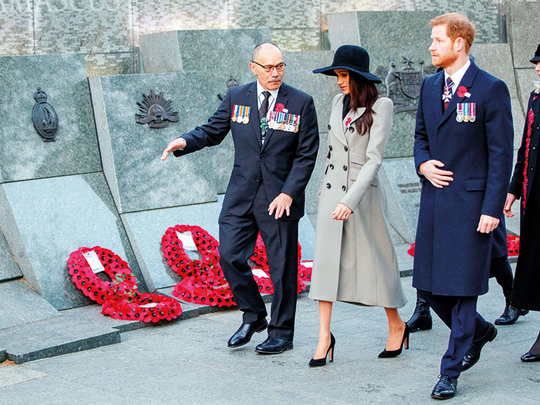
Canberra, Australia: Australians gathered with descendants of former allies and enemies around the country, on a Turkish coast and in a French town Wednesday in dawn services to commemorate the moment when Australian and New Zealand Army Corps troops waded ashore at the Gallipoli peninsula in Turkey 103 years ago in their first major battle of the First World War.
Thousands of Australians gathered in the pre-dawn chill on the Somme in northern France on Wednesday for a poignant ceremony in memory of the soldiers who fought and died on the Western Front, a century on from the end of the First World War.
Some 8,000 Australians made the round-the-world trip to mark a special centenary Anzac Day, Australia’s national day of remembrance on the Somme, scene of some of the most brutal battles of the 1914-18 conflict.
Tony McNiff said it was “spine tingling and extremely emotional” to have made it to the Australian National Memorial, just outside the town of Villers-Bretonneux, the site of a major victory for Australian troops in 1918.
“We’re really among the privileged few to be among the 8,000 here,” McNiff, who served 35 years in the Australian air force, told AFP.
Because extremists have targeted annual ANZAC Day ceremonies in the past, concrete barriers were placed around the service in downtown Sydney to protect those who gathered at Martin Place.
Prime Minister Malcolm Turnbull, his French counterpart, Edouard Philippe, and the heir to the British throne, Prince Charles, marked ANZAC Day in France with a service that also commemorates the 100th anniversary of Australian troops taking the town of Villers-Bretonneux from the Germans in a daring counterattack in the early hours of the third ANZAC Day.
Villers-Bretonneux is now home to the main Australian Memorial of the Western Front.
Phillipe said half the 313,000 Australians who fought in France and Belgium were wounded or died, forging “a brotherhood of spilt blood” with Australia’s allies.
“You sometimes have to die far from home to honour and defend your country,” Phillipe told the gathering in French. “This is the very hard, sometimes bitter reality well known to the French.”
“They suffered lice, rats, gas,” Philippe said, urging leaders to keep memories of the war’s horrors alive.
“They suffered bombardments, lives cut short, cold and hunger.”
Like Turnbull, he paid tribute to his country’s forces serving around the world in current conflicts, from Syria to anti-extremist troops in west Africa.
Turnbull said: “The Australians had come from the other side of the world to defend the freedom of France. We meet here 100 years later on land long healed to remember them.”
Prince Charles said the spirit of Australians killed in Gallipoli and the Western Front “will forever be part of the Australian identity.”
At Villers-Bretonneux, Turnbull and Philippe on Tuesday unveiled a memorial plaque at the new Sir John Monash Centre museum, which is named after the Australian general responsible for taking the town.
Turnbull and his wife, Lucy, also visited the grave of her great-uncle Roger Hughes, who was killed by a German shell in 1916 five days after arriving on the Western Front as a 26-year-old military doctor.
Home Affairs Minister Peter Dutton represented the Australian government at a service at ANZAC Cove at Gallipoli, where the Australian and New Zealand troops landed under British command in an ill-fated attempt to take the Ottoman Empire out of the war.
“It is the greatest honour for all of us to gather here at North Beach as dawn breaks more than a century after this campaign was fought,” Dutton said at a ceremony that brought together Turkish, New Zealand and Australian troops. “It is humbling to stand among our New Zealand and Turkish friends and reflect on the service and sacrifice of the tens of thousands of people on both sides of the campaign who lost their lives.”
More than 44,000 Allied soldiers were killed at Gallipoli. Turkish casualties were estimated at 250,000.
At the Australian War Memorial in the capital, Canberra, an estimated crowd of 38,000 — 10 per cent of the city’s population — gathered in the cool autumn darkness for the dawn service, which began with a lone soldier playing a didgeridoo, in recognition of the contribution of indigenous soldiers.
“The attendance at this year’s dawn service shows the enduring connection so many people have to Anzac Day,” Memorial Director Brendan Nelson said in a statement.
Turnbull and Philippe had on Tuesday opened a high-tech new museum at the Australian memorial designed to bring to life the country’s role on the Western Front.
The €63 million ($76 million; Dh282.6 million) Sir John Monash Centre, named after one of the country’s greatest generals, uses life-size videos of soldiers and a 360-degree cinema to showcase the role of Australian troops.
It showcases Australian soldiers’ diaries, photographs and letters, while visitors can also visit a stretch of rebuilt wartime trench to better understand life at the Front.
The memorial site where it is located is also home to a cemetery where 2,000 Commonwealth troops are buried.
The names of some 11,000 Australian troops, whose bodies were never found, are engraved on its walls.












